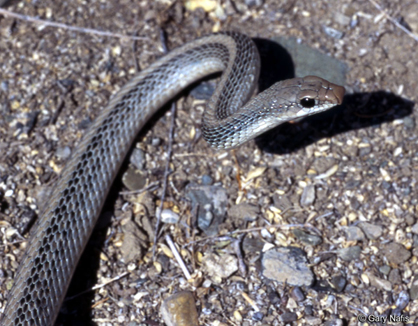Western Patch-nosed Snake
Salvadora hexalepisFamily: Colubridae Order: Squamata Class: Reptilia
DISTRIBUTION, ABUNDANCE, AND SEASONALITY
The western patch-nosed snake is widely distributed throughout the lowlands, up to 2120
m (7000 ft), of southern California from the coast to the eastern border. The species ranges
north in desert habitats through Owens Valley, and also occurs in the vicinity of Honey Lake,
Lassen Co. It is found in coastal chaparral, desert scrub, washes, sandy flats and rocky
areas. It seems to be more common in coastal areas than desert but there is little information
on abundance (Bogert 1939, 1945, Stebbins 1954).
(Habitat examples:
Creosote bush scrub,
Yucca cactus scrub,
Desert wash)
SPECIFIC HABITAT REQUIREMENTS
Feeding: This snake seems to be an opportunistic feeder. Reported prey items are
lizards (Cnemidophorus, Coleonyx), small mammals (Dipodomys), and the eggs of lizards
and snakes. It probably eats anything it can overpower (Stebbins 1954).
Cover: This is an active, diurnal snake. Occasionally, it takes refuge in bushes, rock
crevices and the burrows of other animals. It has been found under objects. It seems able to
thrive in most environments, making use of whatever cover is available (Stebbins 1954).
Reproduction: Nothing is known about reproductive requirements. Probably friable or
sandy soil or the presence of rodent burrows are needed.
Water: Water is probably not required.
Pattern: The western patch-nosed snake is a broad generalist in its diet and habitat
requirements (Stebbins 1954)
SPECIES LIFE HISTORY
Activity Patterns: This species is diurnal. In the milder months of spring it can be found
throughout the day. In summer, activity is restricted to mornings and late afternoons. Snakes
may be active all year in the southern part of the state during mild to warm weather. Normally
snakes are active in spring and early summer with greatest activity occurring in May and
June.
Seasonal Movements/Migration: None.
Home Range: No data.
Territory: No data.
Reproduction: Mating probably takes place from April to June. Clutches average 5 to 6
eggs. Gravid females have been found from May to August (Fitch 1970). Laboratory
incubation of eggs required 85 days (Stebbins 1954).
Niche: The western patch-nosed snake is probably preyed upon by raptors, roadrunners,
most diurnal mammalian carnivores, kingsnakes and other snake predators, but no records of
predation are known. Nothing is known about competitors, diseases, parasites or weather.
This species is widely distributed and poorly known.
Also See:
Side-blotched Lizard - Desert Wildlife
Snake predators include rattlesnakes and sidewinders, coachwhips, racers, gopher snakes, kingsnakes, patch-nosed snakes, long-nosed snakes and night snakes. ...
Joshua Tree National Park Wildlife
Mojave Patch-nosed Snake Salvadora hexalepis mojavensis Most common on sandy valley floors; northern section (common) Smith’s Black-headed Snake ...
REFERENCES
Bogert, C. M. 1939. Notes on snakes of the genus Salvadora with a redescription of a neglected Mexican species. Copeia 1939:140-147.
Bogert, C. M. 1945. Two additional races of the patch-nosed snake, Salvadora hexalepis. Am. Mus. Novitates, 1285:1-14.
Fitch, H. S. 1970. Reproductive cycles in lizards and snakes. Univ. Kans. Mus. Nat. Hist. Misc. Publ. 52:1-247.
Stebbins, R. C. 1954. Amphibians and reptiles of western North America. McGraw-Hill, New York. 536pp.
Stebbins, R. C. 1985. A field guide to western reptiles and amphibians. 2nd ed., revised. Houghton Mifflin, Boston. 336pp.
California Department of Fish and Game. California Interagency Wildlife Task Group.
EXTERNAL LINKS
wildherps.com - Western Patch-nosed Snake (Salvadora hexalepis)
When I was ascertaining this snake's identity, I noticed that according to Stebbins there were two species of patch-nosed snakes recorded for the Sedona ...
eNature.com Nature Guides
Western Patch-nosed Snake Salvadora hexalepis. © Karl H. Switak. This fast-moving, agile species is active much of the day. After warming in the morning sun ...
Western Patch-nosed Snake Photos - Western Patch-nosed Snakes
...See pictures of both venomous and nonvenomous snakes found in the Greater Phoenix area (Maricopa County) including the Western Patch-nosed Snake .
Western Patch-Nosed Snake (Salvadora hexalepis)
This website provides information about Wildlife Around Las Vegas.
Western Patchnose Snake
Western Patch-nosed Snakes are very active in the daytime, like racers and whipsnakes. They are mostly ground-dwellers and move rapidly. ...
Reptiles of Arizona
DIET: The Western Patch-nosed Snake actively forages for lizards, mice and other small mammals, reptile eggs, and birds. REPRODUCTION: Mating takes place in ...
Utah Division of Wildlife Resources
The western patch-nosed snake, Salvadora hexalepis, occurs in desert regions of the southwestern United States and Mexico. In Utah, the species occurs only ...
The San Bernardino County Museum
The Western Patch-nosed Snake is a medium sized snake that bears a large patch-like rostral scale at the tip of its snout. This snake is found in desert ...

Western Patch-nosed Snake
Photo by Gary Nafis